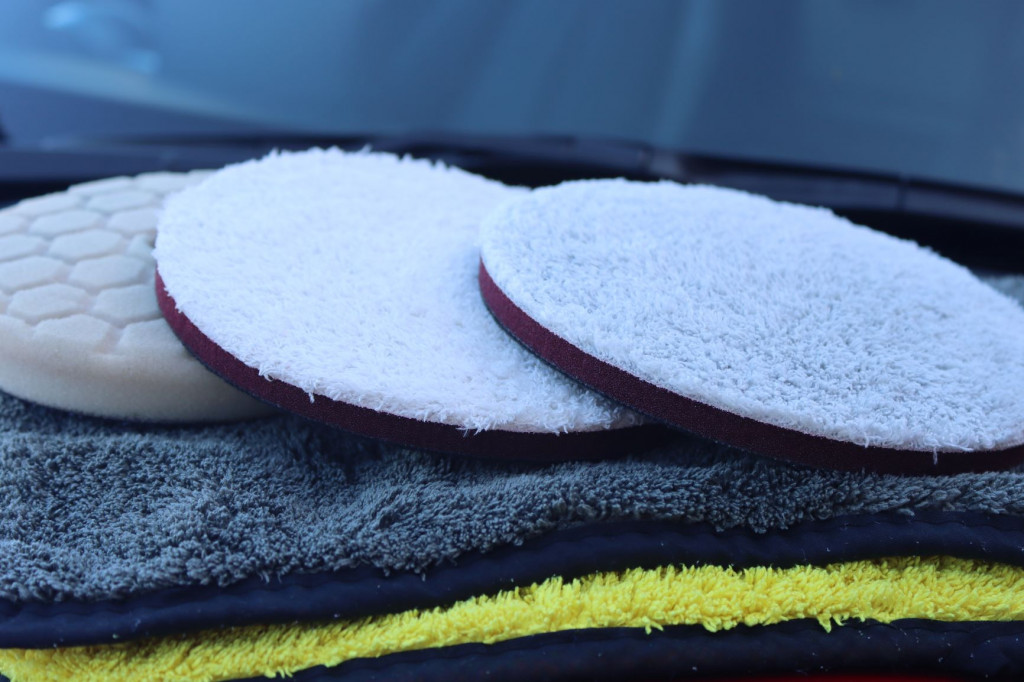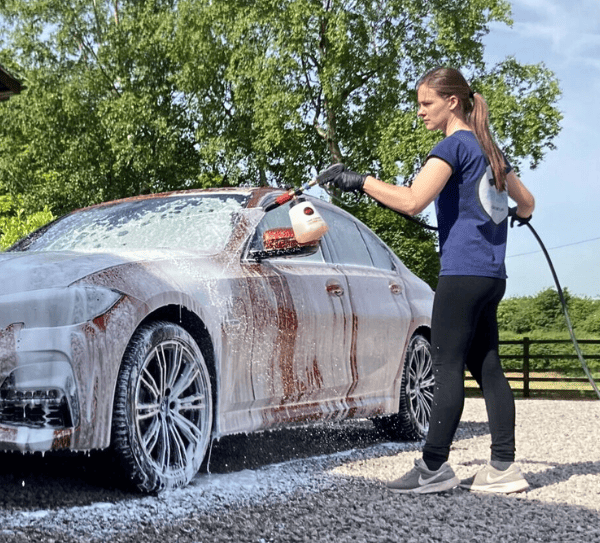There are three options when it comes to polishing pads: foam, wool, and microfiber. There’s a lot of confusion between wool and microfiber pads so I’ll be doing a deep dive into the differences and how to decide which to use.
Microfiber pads are generally more aggressive than wool pads due to their greater surface area. However, wool pads run cooler (which reduces the risk of the paint swelling), and are typically more suitable for softer paints.
| Comparison | Foam Pad | Microfiber Pad | Wool Pad |
| Cutting Power | 8/10 | 10/10 | 9/10 |
| Finishing Ability | 10/10 | 4/10 | 8/10 |
| Minimising Heat | 7/10 | 2/10 | 10/10 |
| Minimising Residue Build-Up | 10/10 | 2/10 | 5/10 |

Intro to Microfiber Pads
Microfiber pads are relatively modern in terms of their use in the automotive industry for paint polishing. They are made of synthetic fibers consisting of polyester and polyamide.
Microfiber pads can vary by:
- Pile length and thickness
- The blend (ratio of polyester and polyamide)
- Strand density
Microfiber by nature grabs onto things very strongly, this includes the paint residue. Microfiber pads also have the greatest surface area (compared to both foam and wool), allowing them to cut quickly and making them ideal for removing heavy defects on hard clear coats.
Intro to Wool Pads
Wool pads are generally made from natural fibres (although some will synthetic fibres) and have been used to polish automotive paintwork for decades.
Wool pads can vary by:
- Pile length and thickness
- Type of wool fibre and blend
- Strand density
- Whether the strands are twisted or not
Wool pads have good cutting and finishing ability, and depending on the paint hardness and the polishing liquid being used, can offer a good level of defect removal and high-gloss finish in a single step.
The main benefit of a wool pad is that it runs quite cool, meaning the paintwork doesn’t swell as much throughout the polishing process. Wool pads are also a good option for softer clear coats.
Direct Comparison of Wool & Foam Pads
In this section I’ll be comparing the following;
- Cutting Ability
- Finishing
- Heat
- Pad Cleaning
- Priming
Cutting Ability
Here we’re talking about how efficiently the pad is able to cut away a defect.
Microfiber pads have more cutting ability compared to wool pads, but both of these options have more cutting power than foam pads. Microfiber pads have the largest surface area and hence greater cutting power making them a suitable option for hard paintwork.
Heat Build-Up
When polishing a vehicle, you want to try and minimise the heat build-up, and this is where wool pads offer an advantage. Wool pads run cooler compared to microfiber pads which are more likely to build up heat.
Keeping that temperature down reduces the chance of the paint swelling so the defects can be removed properly and you can assess the true condition of the paintwork using an inspection light as you go.
Pad Cleaning
Microfiber pads need to be cleaned more frequently during the polishing process and replaced more often) compared to wool pads. This is because microfiber pads get clogged with paint residue so need blowing out between sets to avoid them becoming loaded too quickly.
Wool pads do also need to be cleaned often though, again to stop them becoming loaded with residue, they’re just not quite as prone to it compared to microfiber pads.
To clean microfiber or wool pads pads between sets you can use compressed air or a brush (e.g. Rupes Claw Pad Brush). Compressed air is the more effective option here, so if you are just using a brush then you may need to replace the pad more often.
Finishing Ability
Wool pads tend to finish down better than microfiber pads which have more of tendency to leave some hazing/ marring behind.
Depending on the polish used, and the hardness of the paintwork, wool pads can be used to cut and finish the paintwork to a high-gloss using a single step.
Some detailers also use microfiber to cut and finish, but in most cases (especially on soft paints), a second step will be required using a soft foam pad and finishing polishing to remove the haze left behind. This is especially the case if the pads are not kept clean enough.
Priming the Pad
Priming both wool and microfiber pads is absolutely essential, otherwise the dry fibres can cause marring. The process remains the same for both wool and microfiber pads:
- Apply the compound/ polishing liquid in a thin layer over the whole pad and spread using the nozzle of the bottle
- Put the pad to the paint and run on low speed (1-2) for about 15 seconds
- Repeat if necessary
You need to make sure all the fibres are coated in the polish/ compound liquid before proceeding with the set. Once the pad has been primed, you can use about 4 pea-sized dots for each set.
Which Should You Use?
Microfiber pads are ideal if you want to cut heavy defects on harder paints, due to the increased surface area. However, you should be mindful of the heat and residue build-up when working with them. Wool pads run cooler and are more suitable for softer paintworks, but still have more cutting ability compared to foam pads.
Remember that not every wool and microfiber pad is made equally, in fact there’s a huge variation in the physical characteristics and as a result, the level of aggression of different pads of the same type. The polishing/ compounding liquid also plays a crucial role in the cutting and finishing ability of a combination.
Check out this comparison between foam and microfiber polishing pads.

